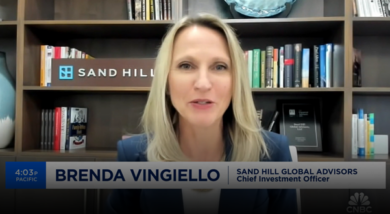Brenda Vingiello, Sand Hill's Chief Investment Officer, joined the Halftime Report to discuss the software space. This content was produced and provided by an unaffiliated

Writing History One Day at a Time
May 2, 2022
Without a doubt, the past few years—and probably the rest of this decade—will ultimately be memorialized in the history books as quite unique, given the nature of the pandemic and the extraordinary fiscal and monetary responses to the economic conditions that it prompted. As students of our time, we have all learned that living through the making of such new historical circumstances can be uncomfortable. It is filled with extreme uncertainty as governments, central banks, and everyday people second guess decisions; and it leads to many potential unintended consequences of those decisions along the way.
With vaccines now widely available and “herd immunity” potentially closer to reality, we are likely now embarking on a new phase of post-pandemic life. Unfortunately, this stage also has its fair share of challenges as we grapple with the impact of an economy that has endured too much stimulus and resulting interest rates that remain far too low. With inflation now at multi-decade highs and the Federal Reserve committed to an aggressive interest rate hiking cycle, we are again finding ourselves at another historic, and uncertain, moment in time.
Despite the economy being presently strong, many economic strategists and media outlets are nonetheless projecting a gloomy outlook. Understandably, their forecasts are based on previous interest rate cycles when the Federal Reserve aggressively raised interest rates. During many of these cycles, the Federal Reserve improperly gauged the economic harm being caused by rate hikes and ultimately caused recessions. Admittedly, the Federal Reserve is likely to aggressively raise interest rates this year, but there are many elements of the current environment that make it less likely, in our view, that history will simply repeat itself.
We believe the most compelling reason for the Federal Reserve to raise interest rates is not only inflation, but the sheer strength of the economy. By many measures, the economy is healthier than it was pre-pandemic, yet interest rates are still effectively zero—having only been increased one time recently to 0.25%. This compares to a Fed Funds rate that was 2.4% throughout most of 2019. The labor market is one of the areas of the economy where this economic strength is most apparent. According to the U.S. Bureau of Labor Statistics, the number of job openings in February of this year was 11.3 million and the unemployment rate was 3.8%. This compares to 6.4 million open jobs and an unemployment rate of 3.5% in December of 2019. It is notable that the job market recovery took only two years as opposed to ten years during the last economic cycle, and this is part of the reason why the Federal Reserve is so far behind at this point. As the Federal Reserve raises rates aggressively and the economy slows, we may find that job openings fall, and this would alleviate some of the inflationary pressure coming from wage growth. Importantly, recessions—almost by definition—involve job loss and unemployment, and right now companies are doing anything they can to attract and retain workers. This suggests that a very extreme change would need to occur—probably well beyond a typical rate-normalization back to pre-pandemic levels—to cause such a severe shift in the job market. We don’t see that on the horizon.
The inflationary environment is also contributing to a heightened level of uncertainty and is being driven by many different factors, some of which may not be easily tamed by raising interest rates. With two thirds of GDP being driven by consumers, higher inflation certainly has the potential to cause economic harm if consumers are forced to reduce spending. And yet, so far, economic data as well as recent corporate earnings reflect that consumers are still spending, even though everyone is angry about paying higher prices. While this seems potentially unsustainable, the overall level of consumer savings helps explain why spending has stayed strong. It stood at just over $4 trillion at the end of last year and this compares to a pre-pandemic high of $1.6 trillion. When combined with wage growth and a robust job market, it appears as though the consumer can likely pay higher prices for a period of time, especially as the global economy reopens and travel, recreational activities, and all sorts of services become increasingly easy to enjoy once again. Of course, as savings are depleted, the risk of a slowdown will rise.
We expect inflation to moderate as the year goes on and this should provide some relief to the typical consumer’s savings and spending reserves. The rapid rebound in purchases of cars, furniture, and other durable goods overwhelmed many parts of the global supply chain in recent years and drove prices higher. However, consumer spending patterns have begun to change, and this can be seen in recent quarterly earnings results where airlines reported record traveling and easily increased fares, and conversely the trucking industry showed signs of slowing. This shift in spending away from goods and to services should allow supply chains to catch up, causing prices to stabilize and possibly even decline. Interest rate increases should also curb some demand in the job, housing, and car markets, leading to less wage growth and a stabilization in home and car values.
Whenever economic stimulus gets withdrawn, it leads to heightened levels of uncertainty for investors since it is hard to quantify just what the resulting economic impact will be. The unique nature of the pandemic plus the fact that most people investing today never previously invested through any periods of rising interest rates or severe inflation only makes matters worse. Yet, given the very strong economic backdrop, and the fact that the Fed Funds rate is still only 0.25% while the economy is now stronger than it was before the pandemic, it would seem that some economic slowing at this point is appropriate, and justified. However, forging a unique path for the history books isn’t an easy task as no one can rely on historical events for guidance. Our preference is to focus on forward-looking data because it usually tells a much different story than media headlines. Trends could certainly change, particularly if the job market weakens significantly. Losing a job, or the fear of losing a job, is a big reason to stop spending. In this regard, we would certainly expect history to repeat itself; but then again, we feel that this is an unlikely outcome in 2022 and perhaps even in 2023 considering the significant strength that we are currently seeing. Given our above outlook, we have positioned our current investment allocations with an overweight in both commodities and equity, as these two asset classes typically have the ability to benefit from inflation when demand is high. This is apparent in the current environment as corporate earnings have remained strong and demand for many commodities is exceeding supply. On the other hand, we have been underweight in bonds since they experience declines and increased volatility when interest rates rise. As interest rates rise, bonds will eventually become more attractive, particularly if they begin to generate yields in excess of inflation, and this is when we would probably look to increase some exposure to this asset class. In the meantime, we will continue to be alert and astute students of the market and take our evolving history one day a time.
Articles and Commentary
Information provided in written articles are for informational purposes only and should not be considered investment advice. There is a risk of loss from investments in securities, including the risk of loss of principal. The information contained herein reflects Sand Hill Global Advisors' (“SHGA”) views as of the date of publication. Such views are subject to change at any time without notice due to changes in market or economic conditions and may not necessarily come to pass. SHGA does not provide tax or legal advice. To the extent that any material herein concerns tax or legal matters, such information is not intended to be solely relied upon nor used for the purpose of making tax and/or legal decisions without first seeking independent advice from a tax and/or legal professional. SHGA has obtained the information provided herein from various third party sources believed to be reliable but such information is not guaranteed. Certain links in this site connect to other websites maintained by third parties over whom SHGA has no control. SHGA makes no representations as to the accuracy or any other aspect of information contained in other Web Sites. Any forward looking statements or forecasts are based on assumptions and actual results are expected to vary from any such statements or forecasts. No reliance should be placed on any such statements or forecasts when making any investment decision. SHGA is not responsible for the consequences of any decisions or actions taken as a result of information provided in this presentation and does not warrant or guarantee the accuracy or completeness of this information. No part of this material may be (i) copied, photocopied, or duplicated in any form, by any means, or (ii) redistributed without the prior written consent of SHGA.
Video Presentations
All video presentations discuss certain investment products and/or securities and are being provided for informational purposes only, and should not be considered, and is not, investment, financial planning, tax or legal advice; nor is it a recommendation to buy or sell any securities. Investing in securities involves varying degrees of risk, and there can be no assurance that any specific investment will be profitable or suitable for a particular client’s financial situation or risk tolerance. Past performance is not a guarantee of future returns. Individual performance results will vary. The opinions expressed in the video reflect Sand Hill Global Advisor’s (“SHGA”) or Brenda Vingiello’s (as applicable) views as of the date of the video. Such views are subject to change at any point without notice. Any comments, opinions, or recommendations made by any host or other guest not affiliated with SHGA in this video do not necessarily reflect the views of SHGA, and non-SHGA persons appearing in this video do not fall under the supervisory purview of SHGA. You should not treat any opinion expressed by SHGA or Ms. Vingiello as a specific inducement to make a particular investment or follow a particular strategy, but only as an expression of general opinion. Nothing presented herein is or is intended to constitute investment advice, and no investment decision should be made based solely on any information provided on this video. There is a risk of loss from an investment in securities, including the risk of loss of principal. Neither SHGA nor Ms. Vingiello guarantees any specific outcome or profit. Any forward-looking statements or forecasts contained in the video are based on assumptions and actual results may vary from any such statements or forecasts. SHGA or one of its employees may have a position in the securities discussed and may purchase or sell such securities from time to time. Some of the information in this video has been obtained from third party sources. While SHGA believes such third-party information is reliable, SHGA does not guarantee its accuracy, timeliness or completeness. SHGA encourages you to consult with a professional financial advisor prior to making any investment decision.







